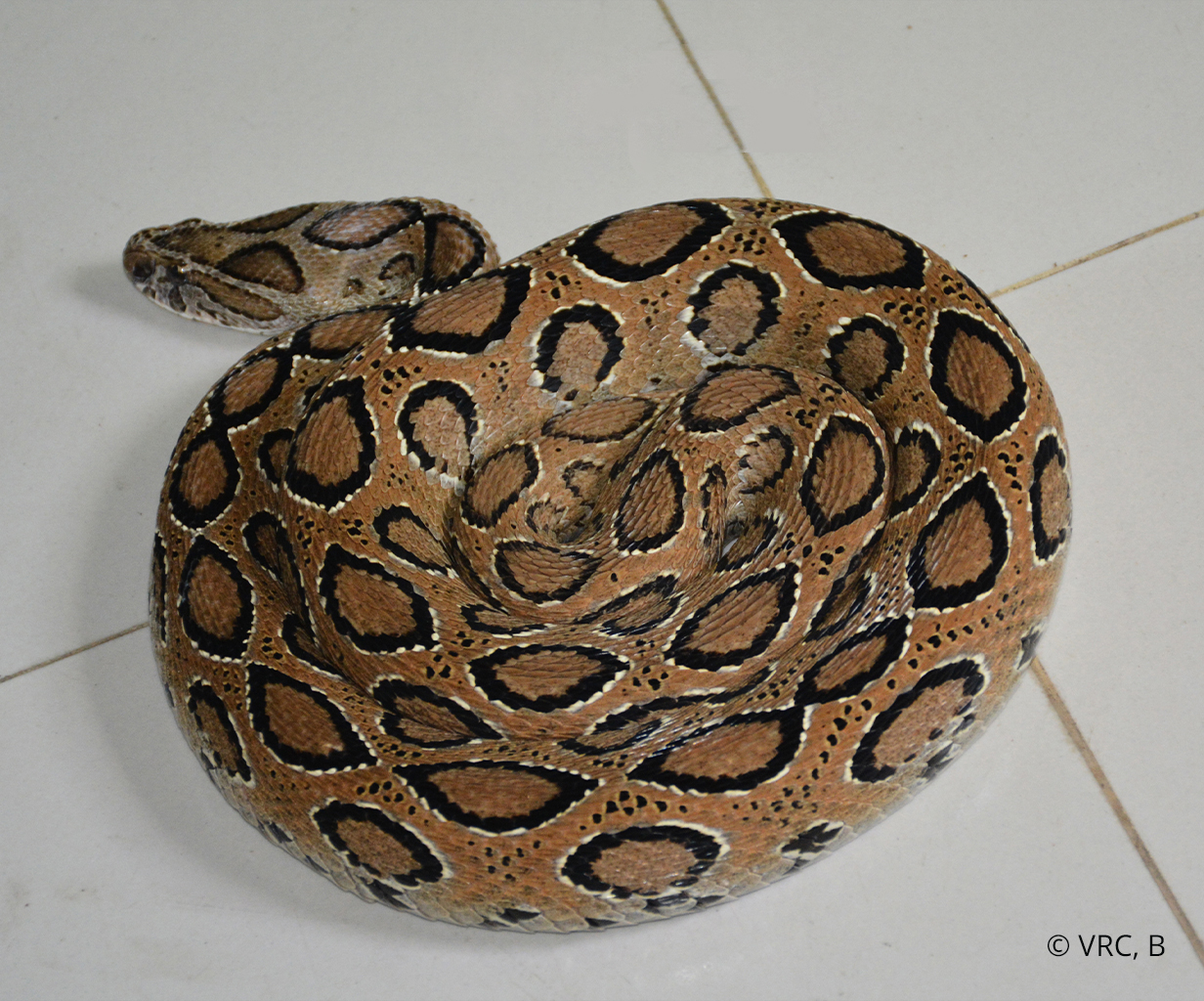- Reports of bites from Russell’s viper, the deadliest snake on the Indian subcontinent, have increased in Bangladesh since 2013.
- At least 20 deaths were recorded from 17 of Bangladesh’s 64 districts between 2013 and 2016, all attributed to Russell’s vipers.
- Researchers attribute this to improvements in farming intensification, which means rats — the snake’s prey of choice — are present in crop fields year-round, whereas before they were only there for part of the year.
- Snakebites are a significant cause of illness and mortality in Bangladesh, with an estimated 6,041 deaths annually, but Bangladesh still relies on imported antivenom — although a newly established Venom Research Centre aims to address this shortcoming and boost research on the country’s venomous snakes.
One of the deadliest snakes on the Indian subcontinent is growing increasingly common in Bangladesh, spurring questions about the country’s preparedness to deal with venomous snakes in general.
Russell’s viper (Daboia russelii) is responsible for nearly half of snakebites in neighboring India, but in Bangladesh, where it’s known as chandra bora, it was thought to be an exceedingly rare species for more than a century. That changed in 2013, however, when a flurry of snakebite cases, many of them fatal, began to be reported, with most of those killed farmers working in their fields.
A 2018 study recorded 20 deaths due to Russell’s viper bites between 2013 and 2016, and identified reports of bites from this species in 17 of Bangladesh’s 64 districts. It attributed the snake’s “booming” population to improvements in irrigation systems, which allowed farmers to cultivate crops on their fields throughout the year, instead of only for part of the year as previously.
That means that rats, the viper’s prey of choice, are also present in the fields year-round, where they feed on the crops. This in turn allows the vipers more opportunities for reproduction and population growth, according to study co-author Md. Farid Ahsan, a professor at the University of Chittagong’s Department of Zoology.

Experts also point to altered land use as another factor behind the resurgence of Russell’s vipers, especially in the snakebite hotspots of Rajshahi and Chapai Nawabganj districts.
According to Pavel Partha, director of the Bangladesh Resource Centre for Indigenous Knowledge (BARCIK) and an expert on ecology and biodiversity, the historically arid and semi-terraced terrain of these districts allowed for crops to be cultivated only once a year. To increase crop cultivation by transforming the terrain to flat plains, the government installed groundwater-based irrigation infrastructure in the 1990s, which Parth said might have destroyed the viper’s habitat and flushed the snake out into closer contact with humans.
Plenty of snakes, very little antivenom
The snakes of Bangladesh have historically received little attention, with studies focusing mostly on species identification and distribution. As in India, vipers, cobras and kraits are the three most common venomous snakes.
According to the Bangladesh National Guideline for Management of Snakebite, there are approximately 100 snake species in the country, of which 37 are venomous: 16 sea snakes, three cobras (including the king cobra, Ophiophagus hannah), five kraits, two coral snakes, six pit vipers, and one true viper: Russell’s viper.

That makes snakebites a significant cause of disease and death in Bangladesh. Recent nationwide epidemiological surveys projected 623 snakebites per 100,000 cases, and 6,041 fatalities per year. Most snakebites occur during the monsoon season are associated with work-related activities.
Yet despite how common the problem is, diagnosing snakebites is one of the most challenging elements of treatment in Bangladesh. Due to the lack of a serological test to identify the presence of venom in the victim’s sample, the diagnosis depends in part on testimony from the victim or witnesses, or the treating doctor if the snake is caught, said Aniruddha Ghose, principal investigator at the Venom Research Centre Bangladesh, a government-funded initiative.
In cases when bites meet specific criteria, the current national guideline suggests using antivenom. However, the country doesn’t have its own homegrown antivenom, and has to rely on imports of this lifesaving elixir.
Recognizing the importance of developing antivenom domestically and developing further research facilities for snakes in Bangladesh, the government initiated the Venom Research Centre with the collaboration of various national and international institutes in 2018.
Among its many objectives, the primary one is to develop antivenom to treat bites from a wide range of venomous snakes, said Ghose, who is also a medicine specialist at Chittagong Medical College.
Banner image: A Russell’s viper (Daboia russelii). Image by Rushen via Flickr (CC BY-SA 2.0).
Red coral kukri sightings in Bangladesh prompt call to save rare snake habitat
Citations:
Ahsan, M. F., & Saeed, M. A. (2018). Russell’s viper (Daboia russelii) in Bangladesh: Its boom and threat to human life. Journal of the Asiatic Society of Bangladesh, Science, 44(1), 15-22. doi:10.3329/jasbs.v44i1.46542
Ghose, A., & Faiz, A. (2014). Snake envenomation in Bangladesh. In: Gopalakrishnakone, P., Faiz, S., Gnanathasan, C., Habib, A., Fernando, R., Yang, CC. (eds) Clinical Toxinology. Springer, Dordrecht. doi:10.1007/978-94-007-6288-6_25-1
Rahman, R., Faiz, M. A., Selim, S., Rahman, B., Basher, A., Jones, A. … Milton, A. H. (2010) Annual incidence of snake bite in rural Bangladesh. PLOS Neglected Tropical Diseases, 4(10), e860. doi:10.1371/journal.pntd.0000860
